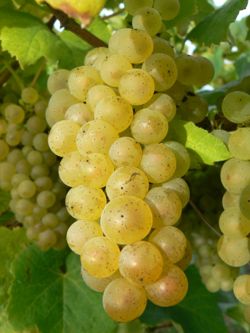Loire Valley 2011 – final vintage report

Guest contributor
Tuesday 13 March 2012
• 4 min read

Charles (left, clearly enjoying the harvest) and Philippa Sydney, wine brokers in the Loire Valley with a passion for the region and extreme determination to support its wine growers, have sent us this update on their preliminary report on the 2011 harvest, published last September.
Apparently the wish 'may you live in interesting times' is considered a curse by the Chinese. Here in the Loire, times are certainly interesting, sometimes a challenge too, but equally hugely rewarding – especially in a vintage like 2011!
You'll have gathered from our preliminary report that the start to the vintage was 3-4 weeks earlier than usual (around 22 August in Muscadet) and less than even. To the extent that in early September we gave serious thought to calling this the 'black and white' vintage to reflect the quantities of carbon and sugar being used to correct rot and an obvious lack of ripeness in wines picked in the hot, damp conditions of the start of the harvest.
You may also remember our report on the 2002 'Lazarus Vintage' when we quoted Pierre Couly saying that it was the first 3 weeks and the last 3 weeks that counted – and that the rest of the summer was, frankly, irrelevant …
Which sort of sums it up ... and explains our use of 'Le Grand Ecart ('the splits' in ballet) to describe the vintage ... with some wines showing the extremes of 1994's horrors and others exceeding years like 2005 and 2009 for quality and fruit.
 Muscadet was ... compliqué. Given the financial problems of a region still trying to recover from the 2008 spring frost, too many people didn't have the money to treat against rot or mildew – and it showed clearly during the harvest, when you could see a patchwork of brown leaves (mildew) contrasting with healthier green – and vineyards that had not been and never will be picked. Tasting the juice, contamination with geosmin [a earthy-smelling compound caused by mould] was obvious, so it was a great relief to see those négociants who were buying in grapes (Lionel Métaireau chez Bougrier, Pierre Sauvion at Grands Chais de France's Lacheteau) systematically treating the juice with carbon, racking it onto the lees of the 2010 vintage and boosting the fermentations with aromatic yeasts.
Muscadet was ... compliqué. Given the financial problems of a region still trying to recover from the 2008 spring frost, too many people didn't have the money to treat against rot or mildew – and it showed clearly during the harvest, when you could see a patchwork of brown leaves (mildew) contrasting with healthier green – and vineyards that had not been and never will be picked. Tasting the juice, contamination with geosmin [a earthy-smelling compound caused by mould] was obvious, so it was a great relief to see those négociants who were buying in grapes (Lionel Métaireau chez Bougrier, Pierre Sauvion at Grands Chais de France's Lacheteau) systematically treating the juice with carbon, racking it onto the lees of the 2010 vintage and boosting the fermentations with aromatic yeasts. Tasting the wines six weeks later was a revelation – dramatic proof of the improvements in winemaking over the last 20 years, as the wines are fresh, aromatic and delightfully easy. Not long keepers, maybe, but they'll be fine until the 2012s come on stream next year.
Meanwhile, further proof of the improvements of the last 20 years was visible chez Pierre Lieubeau at La Fruitière and Jérôme Choblet in the Côtes de Grandlieu, where coherent, reasoned vineyard management allowed them to wait till the grapes were ripe, picking between 11 and 11.5% at harvest. The photo on the left says it all!
For the sauvignons in the Touraine, things were clearly not easy either – with the word compliqué on every grower's lips and serious choices needing to be made on how best to work the grapes as problems of rot and geosmin were widespread, not sparing growers in Sancerre or Pouilly either – while Quincy had to cope with yet another harvest decimated by hail.
For some growers, hand picking with a severe tri [sorting] selective picking was the answer – in others, I'd say quality was better assured with the new generation of machines such as the Pellenc, which with their built-in tri assured a fine harvest with the ability to pick rapidly as grapes reached ripeness.
Despite the obviously difficult vintage, the results are good – big, easy-going wines with loads of fruit, lowish acidity (which may upset the fans of minerality but which will most certainly please the average consumer) and plenty of concentration and flavour.
And then those three weeks of sunshine started to kick in…
 The red Cabernet Francs of Chinon, Bourgueil and Saumur-Champigny are textbook examples of the importance of terroir – and of modern vineyard management: the early-ripening sand and gravel vineyards needed picking by mid September as they were starting to show signs of rot. Up the slopes, however, better drainage and exposition meant the growers could wait, with Couly-Dutheil, Charles Joguet and Philippe Vatan each waiting until the last week of September to pick their better vineyards, bringing in grapes with (a) a big grin and (b) full phenolic maturity, with degrees in some cases hitting a neat 15° Baumé.
The red Cabernet Francs of Chinon, Bourgueil and Saumur-Champigny are textbook examples of the importance of terroir – and of modern vineyard management: the early-ripening sand and gravel vineyards needed picking by mid September as they were starting to show signs of rot. Up the slopes, however, better drainage and exposition meant the growers could wait, with Couly-Dutheil, Charles Joguet and Philippe Vatan each waiting until the last week of September to pick their better vineyards, bringing in grapes with (a) a big grin and (b) full phenolic maturity, with degrees in some cases hitting a neat 15° Baumé. The results with these growers are real stunners, wines with huge, fat and soft fruit and that delicious sucrosité and low acidity that comes with genuine maturity – wines easily on a par with (and maybe better than) 2005.
 Up river, the chenins of Vouvray and Montlouis are fine too – despite problems we associate with high-density planting and its associated low foliage and grapes close to the soil, the vintage is fine, almost certainly better than 2010. There's loads of fruit, loads of flavour and a balance of acidity that'll make these really tasty wines to drink young.
Up river, the chenins of Vouvray and Montlouis are fine too – despite problems we associate with high-density planting and its associated low foliage and grapes close to the soil, the vintage is fine, almost certainly better than 2010. There's loads of fruit, loads of flavour and a balance of acidity that'll make these really tasty wines to drink young. Downstream, though, in the Anjou and – especially – in the Coteaux du Layon, the Chenin Blanc has really shown the world-beating potential of the Loire, with Gilles Bigot at Château de Fesles bringing in his first tri of Bonnezeaux at between 22 and 23° potential, while in Chaume young Stéphane Branchereau picked 20 hectolitres (that's 5 x 400-litre casks) with a potential of 32° Baumé.
Damn ... we could have called this the 'smiley vintage' again!
A final point – prices… most consumers won't have noticed, but over the last four years the guys have worked hard to hold or even reduce prices, which are often lower now than they were 10 years ago. This year isn't that different in that we expect your beloved UK chancellor to raise duty by another 12 pence [14 euro cents/19 US cents] – but it is different in that for the first time in over five years the pound has gained some ground against the euro, making our wines that touch more competitive – and effectively compensating for that *@xxarggh duty increase, so I hope you'll understand us relaxing a bit of the pressure and accepting the occasional price increase where necessary to ensure continued investments in improved quality.
Become a member to view this article and thousands more!
Premium
- 15,434 featured articles
- 274,219 wine reviews
- Maps from The World Atlas of Wine, 8th edition (RRP £50)
- The Oxford Companion to Wine, 5th edition (RRP £50)
- Members’ forum
Monthly
Annually
£99
Save 10% with annual membership
Professional
- 15,434 featured articles
- 274,219 wine reviews
- Maps from The World Atlas of Wine, 8th edition (RRP £50)
- The Oxford Companion to Wine, 5th edition (RRP £50)
- Members’ forum
- Commercial use of our Tasting Notes
£199
per year